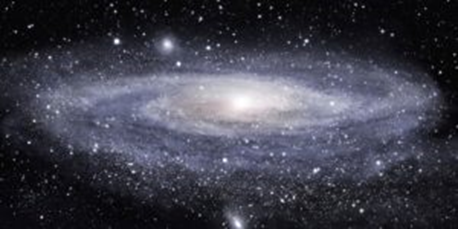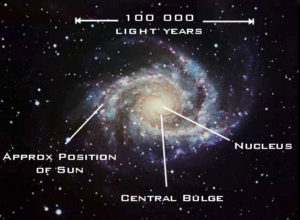Science > Physics > Astronomical Physics > Our Galaxy
The stars, the planets, the moon and many other objects in the sky are called celestial or heavenly bodies. The universe includes everything that exists. The branch of science that deals with the study of the universe is called astronomy. The Big Bang Theory is the most widely accepted theory about the origin of the universe. According to this theory, the universe emerged from an extremely dense and hot state. This was followed by a huge explosion, which gave birth to our universe, and it is assumed to be ever-expanding.
A cluster of stars is called Galaxy. A galaxy contains billions of stars. Galaxies exist in different shapes. The two most common shapes are elliptical and spiral. Our galaxy is a spiral galaxy. The galaxies having no specific shapes are called irregular galaxies. Our galaxy is called Milky Way (Akashganga). It consists of 100 billion stars including our sun. There are millions of galaxies like the Milky Way.

Earlier our ancestors learned about the celestial objects through direct and constant observation. At present we use three advanced techniques and methods to study celestial objects. These three techniques are:
- Use of telescope.
- Use of observatories with powerful telescopes
- By sending spaceships to distant planets.

Hubble telescope is the most powerful telescope in space.
The distance between the two celestial objects is very large. Hence it cannot be measured by using our practical terrestrial unit kilometre. The distance between celestial bodies is measured in a unit called a light-year. Though it contains the word year, it is not the unit of time. It is the unit of distance. Light moves at a velocity of about 300,000 kilometres per second. The distance that light can travel in one year is called the light year. So in one year, light can travel about 10 trillion km. More precisely, one light-year is equal to 9,500,000,000,000 kilometers.
Our Galaxy, The Milky Way:
It measures some 120,000–180,000 light-years in diameter. Our Solar System resides roughly 27,000 light-years away from the Galactic Center, on the inner edge of one of the spiral-shaped concentrations of gas and dust particles called the Orion Arm.

Our galaxy is not perfectly disc-shaped but slightly warped.

Scientists believe that 90% of our galaxy’s mass consists of dark matter, which gives it a mysterious halo. The Milky Way has between 100 to 400 billion stars. The Milky Way is full of dust and gas. The Milky Way wasn’t always as it is today. It acquired its current size and shape by eating up other galaxies and is still doing so today. There is a black hole at the centre of the galaxy. Our Milky Way has been around for about 13.6 billion years. Its age is almost equal to that of the universe. The Milky Way, along with everything else in the Universe, is moving through space.
Constellations:
The stars forming a group that has a recognizable shape is called a constellation. The shape of the constellation remains the same. The constellations appear to move in the sky from the east to the west. Actually, the Earth rotates about its axis from the west to the east, hence we see the apparent movement of the constellations from the east to the west.
The constellations are named after observing their shapes and according to the prevailing beliefs or events. A constellation does not have only 5 to 10 stars. It has a large number of stars. However, we see only the bright stars in the constellation with our naked eye. All the stars which make up a constellation are not at the same distance. They are just in the same line of sight in the sky.
Constellation The Great Bear or Ursa Major or Great Dipper or Saptarishi:
The constellation we can see during summertime in the early part of the night is the Great Bear. The Great Bear is also known as Ursa Major or Great Dipper or Saptarishi. There are seven prominent stars in this constellation. It appears like a big ladle or a question mark. Three stars of this constellation are in the handle of the ladle and four in its bowl. A pole star can be located using this constellation.

Constellation the Orion:
The constellation Orion can be easily seen on winter late nights. The Orion is also called the Hunter. The three stars in the middle are said to be Orion’s belt. The Orion has seven to eight bright stars. If the line on the stars from the belt is stretched Eastwards it leads to the star called Sirius. Sirius is the brightest star in the sky.

Constellation Cassiopeia:
Cassiopeia is a prominent constellation in the northern sky which is visible during winter in the early part of the night. Cassiopeia constellation looks like the distorted letter W or M.

Constellation Scorpius:
It is one of the brighter constellations. Stars in this constellation form the image of a scorpion, with a long curving tail. From the northern hemisphere, Scorpius can be seen in the southern sky, close to the horizon. The Antares is the brightest star in the constellation Scorpius It marks as the heart of the scorpion.

International Astronomical Committee:
The whole sky is divided into 88 parts for convenience by International Astronomical Committee / Union (IAC or IAU). There are 37 constellations belonging to the northern sky and 51 constellations belonging to the southern sky.
Indian Contribution:
Ancient Indian astronomers had imagined 27 constellations which they called nakshatras.
| Ashwini | Bharani | Kritika |
| Rohini | Mriga | Ardra |
| Punarvasu | Pushya | Ashlesha |
| Magha | Poorva | Uttara |
| Hasta | Chitra | Swati |
| Vishakha | Anuradha | Jyeshtha |
| Tool | Poorvashadha | Uttarashadha |
| Shravan | Dhanishtha | Shattaraka |
| Poorvabhadrapada | Uttarabhadrapada | Revati |
Western and Tamil Names of Nakshatras:
| Sr. No. | Sanskrit name | Tamil name | Western star name |
| 1 | Ashvinī | Aswini | β and γ Arietis |
| 2 | Bharanī | Baraṇi | 35, 39, and 41 Arietis |
| 3 | Krittikā | Kārthikai | Pleiades |
| 4 | Rohini | Rōhiṇi | Aldebaran |
| 5 | Mrigashīrsha | Mirugasīridam | λ, φ Orionis |
| 6 | Ārdrā | Thiruvādhirai | Betelgeuse |
| 7 | Punarvasu | Punarpoosam | Castor and Pollux |
| 8 | Pushya | Poosam | γ, δ and θ Cancri |
| 9 | Āshleshā | Ayilyam | δ, ε, η, ρ, and σ Hydrae |
| 10 | Maghā | Magam | Regulus |
| 11 | Pūrva or Pūrva Phalgunī | Pooram | δ and θ Leonis |
| 12 | Uttara or Uttara Phalgunī | Uthiram | Denebola |
| 13 | Hasta | Astham | α, β, γ, δ and ε Corvi |
| 14 | Chitrā | Chithirai | Spica |
| 15 | Svātī | Swathi | Arcturus |
| 16 | Vishākhā | Visakam | α, β, γ and ι Librae |
| 17 | Anurādhā | Anusham | β, δ and π Scorpionis |
| 18 | Jyeshtha | Kettai | α, σ, and τ Scorpionis |
| 19 | Mūla | Mūlam | ε, ζ, η, θ, ι, κ, λ, μ and ν Scorpionis |
| 20 | Pūrva Ashādhā | Pūradam | δ and ε Sagittarii |
| 21 | Uttara Ashādhā | Uthirādam | ζ and σ Sagittarii |
| 22 | Shravana | Tiruvōnam | α, β and γ Aquilae |
| 23 | Shravishthā or Dhanishta | Aviṭṭam | α to δ Delphinus |
| 24 | Shatabhishā or Shatataraka | Sadayam | γ Aquarii |
| 25 | Pūrva Bhādrapadā | Pūruruṭṭādhi | α and β Pegasi |
| 26 | Uttara Bhādrapadā | Uttṛṭṭādhi | γ Pegasi and α Andromedae |
| 27 | Revati | Rēvathi | ζ Piscium |